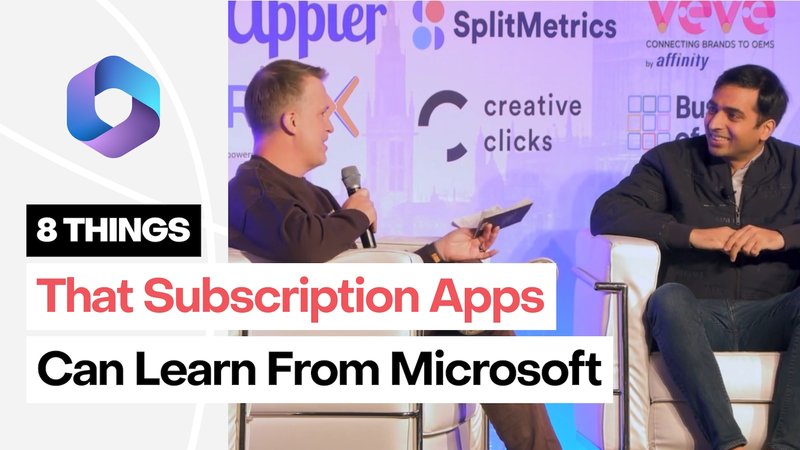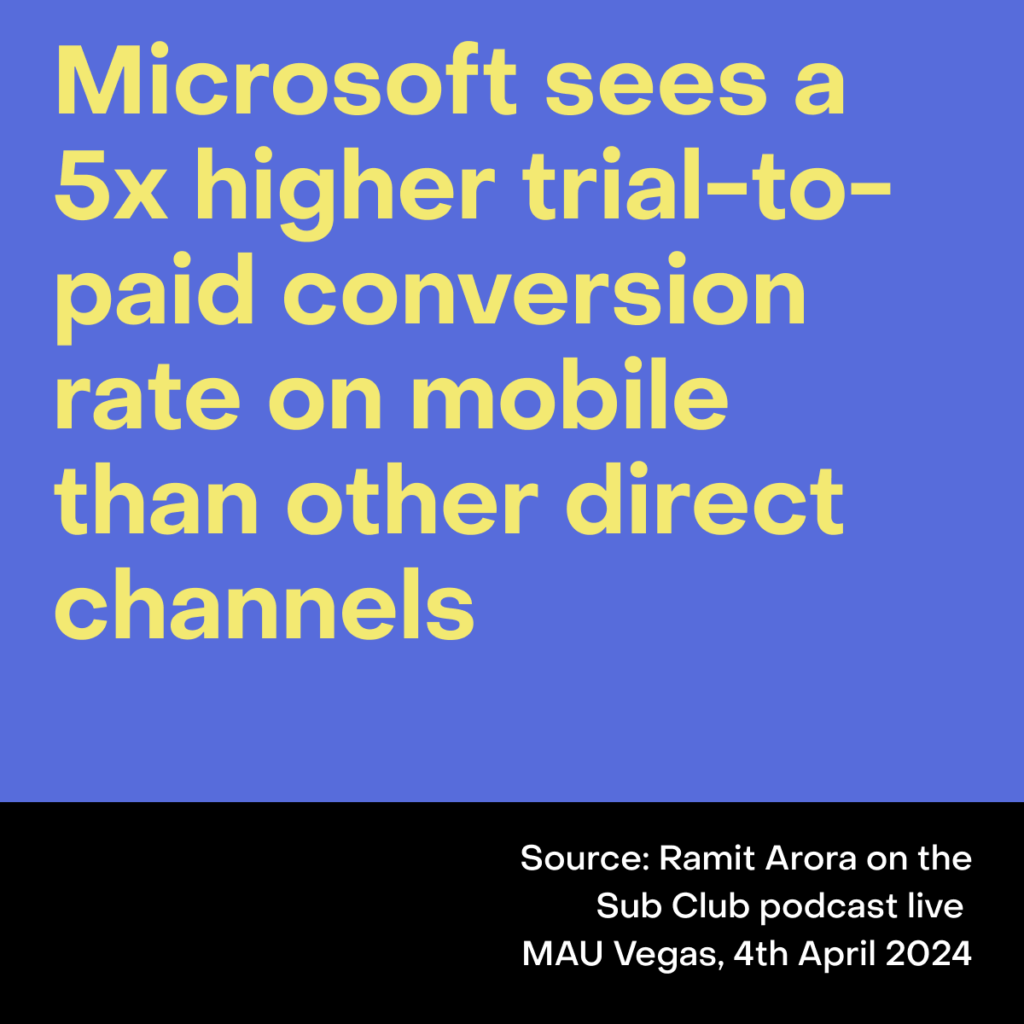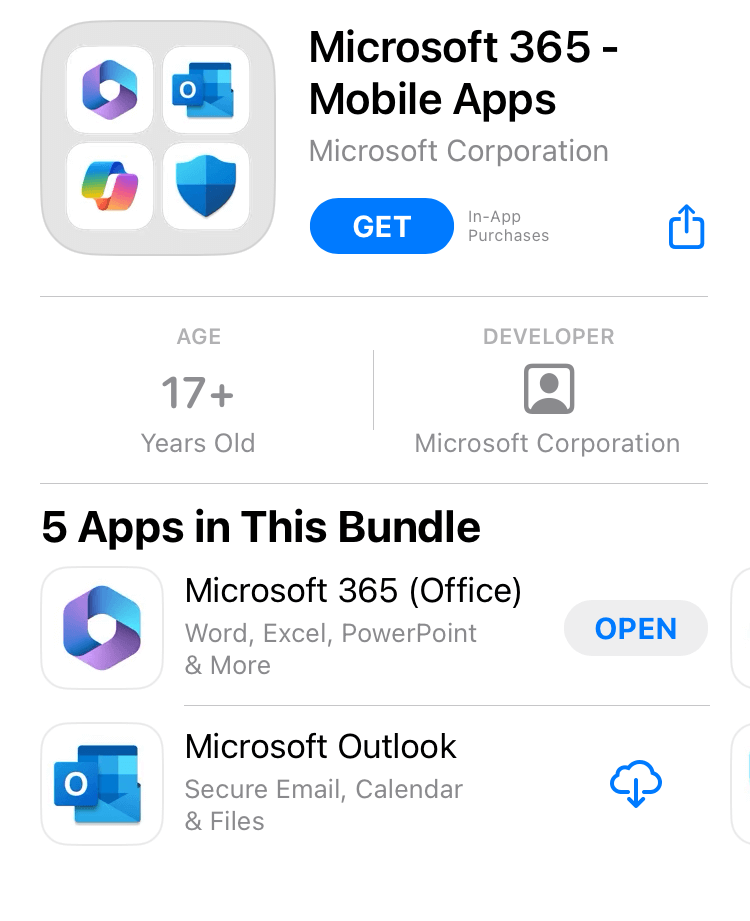8 things Microsoft can teach us about building successful subscription apps
With some of the best monetized productivity apps on the App Store, what can startups learn from the biggest company in the world?

You might be surprised by how much Microsoft, the world’s biggest company, can teach you — an app business with vastly different resources and scale — about building a successful subscription app.
While Microsoft is often associated with enterprise solutions, its approach to consumer app monetization offers valuable insights for startups. Microsoft’s apps are not an afterthought: they are some of the top performers in the App Store.
After chatting with Ramit Arora, the monetization lead product manager for Microsoft 365 and Copilot, we realized there’s a lot that app startups can learn from Microsoft. Not only are Microsoft’s apps some of the top performers in the App Store when it comes to monetization, but Microsoft also needs to think like a startup to stay competitive.
In this blog, I’ll distill two conversations David had with Ramit — one at MAU Vegas and the other at APS London — into key points that all subscription apps can learn from.
To build an app business within the biggest company in the world, you need to think like a startup
To compete on the App Store, Ramit tells us, “you have to operate like a startup”.
Microsoft doesn’t start on a completely level playing field, of course. Some users will come to the App Store and search for Microsoft apps specifically or they might be more willing to download a Microsoft branded app due to brand recognition.
But, generally, any app startup is able to rank for keywords and sit above Microsoft’s apps — and often do. It’s a “democratic” marketplace.
What this means for Microsoft is that it needs to bring its A-game. It cannot afford to coast on its brand name when it comes to app store optimization (ASO) — it needs to try as hard to rank in the top spots as any other app.
💡Takeaway: Remember that you have the ability to compete with companies of Microsoft’s scale on the App Store. To do so, learn from its approach to building successful apps — those learnings are just as applicable to you.
Given the choice, consumers just want to make purchases on their phones
In the early days of Microsoft’s apps, they were seen more as companions to the desktop apps, less as standalone products that would fulfil all of the users’ needs. As time went on, they began to notice that more users were either using their mobile as their primary device (especially in regions outside of the US) or were completing desktop-level tasks on their mobile (such as writing and editing very long-form documents). This was the moment that Microsoft realized they needed to take their apps more seriously.
Another trend they saw with their consumer products (365 and now Copilot) is that users like to make purchases from their phone rather than on their desktop or the web. With a credit card readily attached and a high-degree of trust built with the ecosystem (i.e. in the case, Apple’s App Store), users favor this more frictionless experience.

So much so that in Microsoft’s case, they see almost a 5x higher trial-to-paid conversion rate on mobile than on other direct channels. This might seem intuitive to mobile-first app businesses, but even Microsoft with its heavy desktop legacy sees a similar trend.
💡Takeaway: It’s tempting to think taking payments over the web versus the app will save on fees and therefore generate more revenue, but always keep in mind that app payments will likely see significantly higher conversion rates — coupled with huge organic traffic potential — making those fees more than worth swallowing.
Bundling apps can improve retention
When you purchase a Microsoft 365 subscription, you can gain access to a multitude of apps that serve different use cases. This is especially useful in the productivity space, where many use cases are one-time scenarios. You might download (and pay) for an app that you need this week but, job complete, you unsubscribe and churn. By combining multiple apps serving different jobs into a single subscription, Microsoft can retain more users because there’s a greater chance that the user will see ongoing value.

💡Takeaway: If you have a suite of apps that serve very specific use cases where there’s a high risk of churn, consider bundling your apps into a single cheaper subscription.
To maintain a leadership position, use this framework
To maintain a leadership position — not just on the App Store but in the wider business — Microsoft uses the following framework:
- Neutralize — React to what competitor apps are doing. This doesn’t necessarily mean copying their features but it does mean having an answer to them.
- Differentiate — Build features that are unique to your app. What can you offer that other apps do not?
- Maintain — Keep up with updates and changes from the platform holders, as well as keep on top of bug fixes and other essential maintenance of the app. For Microsoft, there’s sometimes a blurring between maintain and the other categories — for example, making sure their apps had Vision Pro support might not seem essential but when you’re trying to be a “leader”, supporting cutting edge updates is part of their wider maintenance approach.
- Incubate — Devote a percentage of your time and resources to innovation. Microsoft, as their apps are more mature, devotes a relatively higher proportion of their time (Ramit used 30% as an example) to incubation. So when, for example, Apple announces a new shiny thing during WWDC, Microsoft are able to react and respond to that quickly.
When you are thinking about these four things, I think it’s very important to think about them from the lens of jobs-to-be-done. Rather than, say, this competition built something and then we copy — we never copy. We first ask: is this job even important for the customer?
Ramit Arora
💡Takeaway: While you might not be able to devote 30% of your time to incubation, thinking through each of these four categories will help you create and subsequently maintain a leadership position in whatever niche you’re trying to carve for yourself.
Jobs-to-be-done is a framework you can apply to more than product development
Microsoft uses the jobs-to-be-done framework to have a very clear idea of what each of its apps need to allow the user to accomplish. For Word, that might be create a note or write a book, or for Excel that’s create a budget or an invoice.
When thinking about how to respond to new features in competitor apps or emerging technologies, like AI, start with the question: How does this help a user complete their jobs-to-be-done? For AI, specifically, Ramit has an interesting viewpoint, which is to ask: how can this bring a desktop class experience to mobile?
More people may use their phones as primary devices and use them to tackle more complex jobs, but some jobs will nonetheless remain harder to get done on mobile. AI can be used to not only close this gap between mobile and desktop, but even make the mobile AI-assisted feature even easier than the traditional desktop counterpart. An example is using Copilot as a research tool to pull resources (and their references) for a topic from multiple different sources — both the web and your own data from 365.
Jobs-to-be-done as an ASO keyword framework
But beyond feature development, Ramit’s team is applying the jobs-to-be-done framework to areas such as ASO. Many of Microsoft’s apps are very general and so a user looking for an invoicing app may not think to look for Excel. But from Microsoft’s user research, it knows that invoicing is a common job for Excel users. So Ramit’s team builds its ASO keyword strategy around these jobs — and not just jobs-to-be-done, but jobs that Microsoft 365 users are more likely to pay for too.
| Popular jobs-to-be-done keywords that Excel ranks highly for |
| renovation budget |
| make chart |
| budget spreadsheet |
| csv editor |
| monthly budget planner |
| budget tool |
| biz expense tracker |
| room expenses sharing app |
| business budget |
| budget calculator |
| financial planner |
| organize your home |
| organize data |
| family budget |
💡Takeaway: Jobs-to-be-done is an excellent framework to apply to your product development, but it becomes even stronger when you consider these jobs beyond the product. What jobs are potential customers searching for in the App Store? How can you use these jobs in your app’s content marketing?
Estimate the impact of any initiative, optimization, or vendor
Too many apps struggle with prioritization. Which feature should be built next? Should we implement win-back campaigns or run price testing? Do we need a mobile measurement partner (MMP)?
In this blog, we’ve already covered two frameworks to help answer these questions. The next step is impact analysis. Estimating impact applies whether you’re a small app or the size of Microsoft — but the outcomes of the analysis will differ.
Ramit provides two examples. The first goes back to the early days of Microsoft’s consumer apps, around 2015 to 2018. Microsoft implemented an MMP, costing a huge amount because of its large user base. However, the team was still figuring out product-market fit — the products weren’t ready for optimization, making the MMP a wasted expense. The second example highlights Microsoft’s shifting priorities as its monthly active users (MAU) grew. When your MAU hits double or triple figures, you can’t justify spending time on an optimization that will only impact a million users.
You’d be surprised that often the biggest ideas are the simplest ones. Like, let’s do something on purchase or let’s do something on the first run experience, because if you have an app that big, then sometimes the simplest things like performance, reliability, file open speed, size of the app, start to matter a lot. Are we able to get 100% transaction completion? At one point we were seeing 5-6% transaction failure. So we first have to fix that.
Ramit Arora
On the other end of the scale, if your app makes, say, $100k MRR, you might think twice before diving into win-back campaigns, for example. Your churn volume might not be high enough yet for win-backs to make much difference.
High-impact activities that affect the most users are often the simplest. For apps the size of Microsoft’s, optimizing launch speed or overall reliability can have a massive impact — whereas, for smaller less mature apps, activities that progress the road to product-market fit are likely to be a better investment.
💡 Takeaway: When considering an activity or new vendor for your app, estimate the impact. How many users will be affected? How significant is the outcome likely to be? Combine this with an effort estimation to find your low-hanging fruit.
Be mindful of profitability on Android
The monetization gap between Android and iOS is a well-known challenge. While Android boasts a massive install base, its revenue generation often lags behind iOS. This discrepancy requires apps to adopt stricter cost-per-install (CPI) limits with paid ads and carefully manage usage costs with tools like your MMP.
Ramit highlights this issue clearly, saying that for their apps the 80/20 rule (i.e. only 20% of revenue originating from Android) almost applies. This is despite their apps being available in over six app stores, including multiple in China, and despite extensive pre-install deals.
For Android, the cost of acquiring users can be significantly lower, but the conversion rate to paying users is also much lower. This means that while you might drive many installs, the percentage that converts to paying users is minimal. Therefore, you must be extra cautious with Android — both in terms of what you pay for CPI and your organic strategies.
For example, if you use an engagement platform that charges by data points or MAU, be mindful of your costs. Your Android campaigns might start increasing your costs without delivering proportional revenue because the lifetime value (LTV) of an Android user typically isn’t as high as that of an iOS user. Microsoft, despite its vast resources, operates under the same constraints as any consumer SaaS startup, ensuring that LTV to customer acquisition cost (CAC) ratios remain balanced.
Ramit also notes that Android might require more innovative business models and potentially lower price points, especially since many subscriptions are North America-based. It’s about more than just replicating your iOS strategy — Android needs specific strategies tailored to its unique challenges.
💡 Takeaway: When considering initiatives for Android, be mindful of profitability. Strictly control your CPI with paid ads and watch your usage costs. Adopt Android-specific strategies rather than duplicating your iOS plans to effectively crack this promising yet challenging platform.
Sometimes the simplest experiments are the most effective
When it comes to A/B testing and experimentation, starting with the basics can often yield the best results. Ramit shared some straightforward yet powerful experiments from Microsoft’s 365 apps that highlight this:
- Clear CTAs for free trials: One of the simplest but most effective changes was updating the call-to-action (CTA) buttons to clearly communicate the free trial. For instance, changing a button to read “Try Free for One Month” instead of “Buy Now” made users more comfortable clicking, as it alleviated the fear of being charged immediately.
- Using videos and GIFs: Instead of presenting information in text blocks, using cards with GIFs or animations proved highly effective. For example, illustrating benefits like “1TB OneDrive storage for each family member” with a visual representation made the value proposition clearer and more engaging, improving conversion rates.
- Reordering subscription options: By making the more expensive family subscription the default option instead of the personal subscription, Microsoft saw an increase in both subscriptions. One theory as to why the personal plan saw a bump is that by making a more expensive plan default, it made the cheaper plan look like better value in comparison. Additionally, showing the monthly equivalent price for annual subscriptions (e.g., “$8 per month”) helped users perceive the cost as more manageable, boosting conversions. This experimentation with default plans and price anchoring is explored more in our Mojo growth story.

Key takeaways
- Think like a startup: Even as a large company, Microsoft operates with a startup mentality to compete effectively on the App Store. This means continuously optimizing and innovating as if they were a smaller company.
- Don’t underestimate the convenience of in-app purchases: Users prefer making purchases on their phones due to the convenience and trust built with platforms like Apple’s App Store. Microsoft experiences almost a 5x higher trial-to-paid conversion rate on mobile compared to other channels.
- Bundle apps to improve retention: Microsoft’s 365 subscription model bundles multiple apps, providing ongoing value and reducing churn by catering to various use cases.
- Follow a strategic framework: Microsoft’s success is guided by a framework of neutralizing competitors, differentiating with unique features, maintaining the app with updates and bug fixes, and incubating new ideas.
- Apply the jobs-to-be-done framework: Microsoft uses the jobs-to-be-done framework to understand user needs and guide product development and marketing strategies.
- Prioritize impact with initiatives and vendors: Conduct impact analysis to prioritize high-impact activities, ensuring that resources are allocated to the most beneficial optimizations.
- Be mindful of profitability on Android: Android often generates less revenue than iOS, requiring stricter cost management and tailored strategies.
- Start with simple experiments: Simple changes, like clear CTAs and visual aids, can significantly improve conversion rates. Microsoft’s experiments with CTAs, GIFs, and subscription reordering highlight this.
You might also like
- Blog post
The complete guide to SKAdNetwork for subscription apps
Understanding Apple's privacy-first attribution
- Blog post
“A big market is great only if you can take a substantial share of it” — Patrick Falzon, The App Shop
On the podcast: estimating the revenue potential of an app, crafting an exit strategy, and why LTV is such a terrible metric.
- Blog post
Effective testing strategies for low-traffic apps
Is A/B testing off the table? Let’s rethink experimentation.

